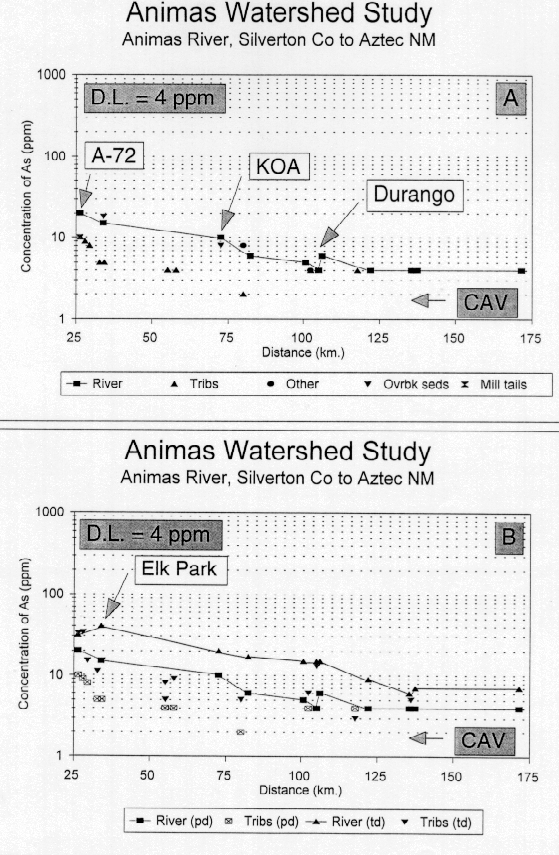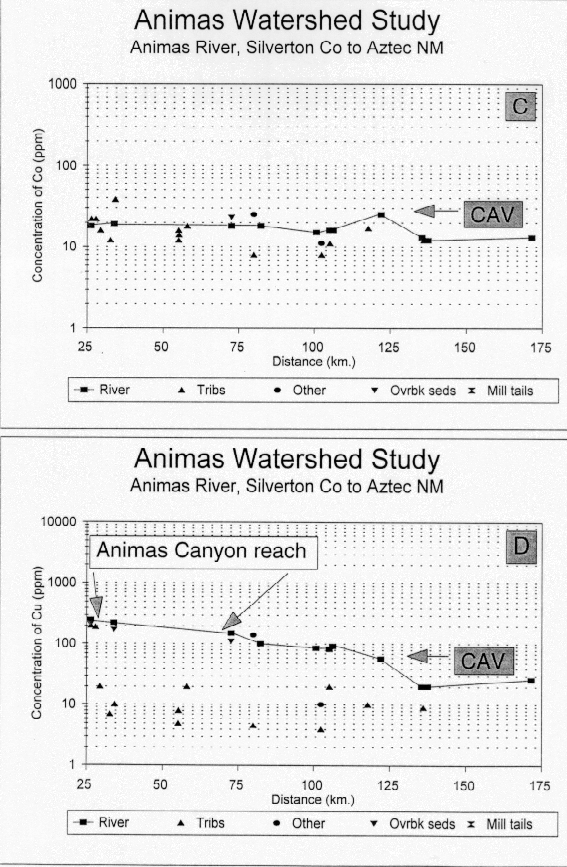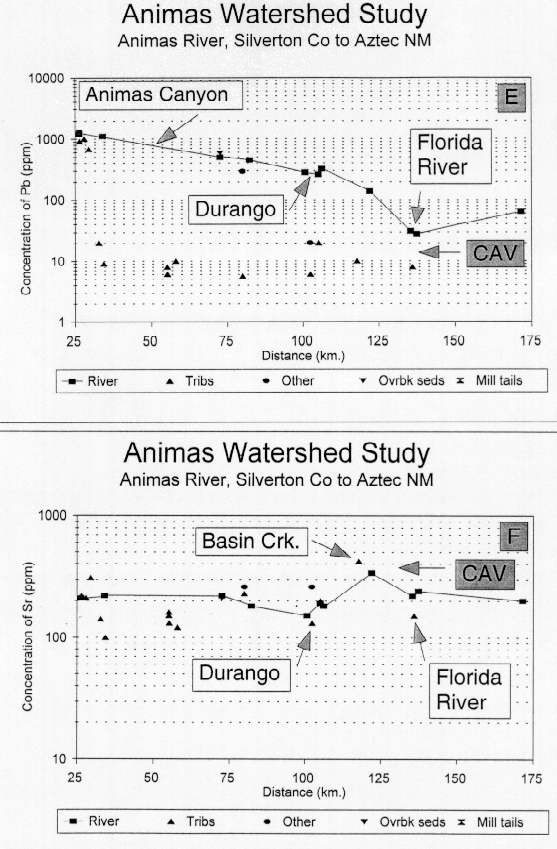The Animas Canyon reach, defined as that reach of the Animas River below Silverton to the KOA Campground sample site below Bakers Bridge (at 72.5 km), and the lower Animas River have very different geologic and resulting physiographic character. In the Canyon reach, the bedrock is Precambrian in age (fig. 3), very resistant to weathering, and supplies a small amount of sediment to the Animas River. The Animas River is highly incised and flows rapidly through the Animas Canyon reach transporting the metals and sediments with little addition to the bed sediments from the tributaries. In contrast, in the lower reaches, the Animas River has formed a wide flood plain on glacial terraces, and it flows in wide, meandering courses containing numerous oxbow lakes. In the lower Animas River reach, the bedrock consists of Paleozoic, Mesozoic, and Tertiary sedimentary rocks that are much more readily weathered. The amount of sediment added by individual tributaries varies greatly. In addition, the Animas River passes through the city of Durango and picks up metal loads of possible anthropogenic origin. This contrast in the basic physiographic and morphological features contribute differentially to the total mass of metals in the bed sediments of the Animas River.
Two overbank samples, one from Elk Park (34 km) and one from the KOA Campground below Bakers Bridge (72.5 km), and a stream-sediment sample from Hermosa Creek (80 km) warrant special mention. The two overbank samples, unlike those from the stream reaches above Silverton, do not have metal concentrations elevated above those found in the Animas River at the point where they were collected. Thus, these data, with the exception of zinc, plot on the metal profile curve for the bed sediments from the Animas River and will not be discussed further in this section. The stream-sediment sample from Hermosa Creek (95ABS135, "Other" was collected from a 0.4 km section of Hermosa Creek that is used by an irrigation company to transfer Animas River water from one irrigation canal to another. This sample, shown as the "Other" sample in figure 28, matches the bed sediment profile of the Animas River quite well. A second sample was collected later from Hermosa Creek at the gaging station (96ABS111) to provide geochemical data for Hermosa Creek. Data from this stream prompted us to look more closely at the samples collected in the earlier reconnaissance geochemical studies and to eliminate sediment samples that were affected by metals present in the water from the irrigation canal as noted above. These sites do not represent the geochemistry of the surrounding area and therefore were eliminated from the geochemical data base used to develop the regional geochemical maps. However, they clearly represent a stream-sediment sample whose geochemistry was greatly influenced by the precipitation of metals from the transported Animas River water.Arsenic concentrations in bed sediments of the Animas River below Silverton drop from 20 ppm in the leach (about 10 times CAV) to near the limit of detection at 4 ppm near Durango (fig. 28A). Comparison of the leach data with the total digestion data (fig. 28B) indicates that the bed-sediment samples from the Animas River contain 5-15 ppm arsenic in either sulfide or silicate phases. Total arsenic concentrations increase immediately downstream in the Animas Canyon at Elk Park (34 km) and may reflect the addition of material from Deadwood Gulch (26.5 km) and Deer Park Creek (28 km) which drain mineralized areas on Sultan Mountain south of Silverton. Sediments from tributaries draining into the Animas Canyon reach contain 5-10 ppm arsenic whereas the samples from the tributaries south of Durango contain 3-5 ppm. Total arsenic concentrations increase from 5 to 7 ppm (three to four times CAV) below Durango (105 km) and may indicate the addition of arsenic from sediments derived from the Mesozoic and Tertiary rocks being eroded in this reach or from the abandoned copper smelter south of Durango.
Cobalt concentrations in the bed sediments of the Animas River below Silverton are nearly constant at about 18 ppm (fig. 28C) except for one site at Weaselskin Bridge (at 122 km). Cobalt concentrations in stream sediments from the tributaries range between 10-15 ppm and are generally somewhat less than that of the bed sediments from the Animas River for most of its distance. Above the confluence of the Florida River (136 km), the concentration of cobalt in the bed sediments of the Animas River and the stream sediments from the tributaries drops to about 12 ppm.
Copper concentrations in the leach digestion decrease uniformly through the Animas Canyon reach from 250 ppm (3.7 times CAV) at Silverton to 58 ppm at Weaselskin Bridge (122 km fig. 28D). Total copper concentrations over this reach drop steadily from 330 ppm at Silverton to 200 ppm at the KOA Campground site (72.5 km), to 120 ppm at Weaselskin Bridge (122 km). Below the confluence with the Florida River (136 km), this component virtually drops abruptly from about 70 ppm to about 20 ppm. This pattern is noted to a lesser degree in the cobalt profile, but is also very pronounced in the zinc and vanadium profiles. From above the confluence of the Florida River southward (136 km), it would appear that all of the metals transported in the heavy-mineral fraction have been effectively buried in the bed sediments and are removed from active communication with the river water except during high-flow stages.
Lead concentrations in the bed sediments of the Animas River below Silverton drop from 1,200 ppm (about 90 times CAV) to about 300 ppm in Durango (100 km about 20-25 times CAV) and to 140 ppm (122 km 10 times CAV) at Weaselskin Bridge (fig. 28E). Below the confluence of the Florida River (136 km), the lead concentration drops to about 30 ppm. However, at Aztec (172 km), the lead concentration rises to 64 ppm. Labile lead concentrations in stream sediments from the tributary samples are uniformly low, generally less than 10 ppm, whereas the total lead concentration in stream sediments from the tributaries is closer to 20 ppm, suggesting that about 50 percent of the lead in the stream sediments from the tributaries is in the silicate phases. However, the lead concentration in the bed sediments over much of the course of the Animas River from Silverton to the confluence of the Florida River (136 km) is totally dominated by leachable lead sorbed onto the iron-hydroxide phase. The rise in the lead concentration in the bed sediment sample from Aztec is interpreted to be the result of accumulation of the iron-hydroxide phase in the sediments because the total digestion data contain only 9 ppm of silicate-bound lead, but 64 ppm of labile lead.
The profile of strontium reflects the geochemistry of bedrock geology of the drainage basin. Through the Animas Canyon reach, there is no change in the strontium concentration in the bed sediments (fig. 28F). Strontium concentrations in the tributaries draining Precambrian rocks (fig. 3) are lower than that in the bed sediments of the Animas River and have only a minor dilution effect on strontium concentrations in the bed sediments. Below the KOA Campground (72.5 km), strontium concentrations drop in response to sediment being added by tributaries draining basins underlain by Paleozoic rocks. Between Durango and the confluence of the Florida River (100-136 km), there is a dramatic increase in strontium in the bed sediments reflecting sediments derived from the Upper Cretaceous Picture Cliffs, Kirtland, and Fruitland Formations, and the lower Tertiary Animas Formation (fig. 3). The sample from Basin Creek (118 km) has a strontium concentration of 420 ppm. South of the confluence with the Florida River, the strontium concentration in the bed sediments of the Animas River again drops to 200 ppm at Aztec. The strontium data and the heavy-mineral data from the copper, vanadium and zinc profiles all indicate that there is a substantial volume of sediment added to the Animas River between Durango and the Colorado-New Mexico state line (140 km).
Zinc concentrations in the 2M HCl-1%H2O2 digestion are about 800 ppm at Silverton and increase to 1,200 ppm in the bed sediment from the Animas River collected from the KOA Campground site (72.5 km) at the base of the Animas Canyon reach (fig. 28G) indicating a substantial gain in labile zinc in the iron-hydroxide phase in the Animas Canyon reach. This corresponds to a loss of dissolved zinc mass from the water in this stream reach. Labile zinc in stream sediments from the tributaries, except for those from Deadwood Gulch and Deer Park Creek (26.5-28 km), have zinc concentrations of less than 100 ppm. Labile zinc concentrations in the two overbank sediments are lower than in the bed sediments from the Animas River. This is the reverse of what was seen in overbank sediments from reaches above Silverton where the zinc concentration in overbank sediments was always elevated above the concentration in the bed sediment collected at that site. Labile zinc concentrations drop substantially between the KOA Campground site (72.5 km) and the Trimble Bridge site (82 km), and then gradually increase to the Weaselskin Bridge site (122 km). Below the confluence of the Florida River (136 km), labile zinc concentrations drop from 1,100 ppm to 240 ppm but rise again to 290 ppm at Aztec (172 km).
Total zinc concentrations behave quite differently (fig. 28H). At the Animas River site below Silverton (A-72) only 44 percent of the zinc is in the iron-hydroxide phase. Most of the zinc in the bed sediments is in sphalerite. At Elk Park (34 km), the labile zinc concentration decreased to only 30 percent of the total zinc present. At the KOA Campground site (72.5 km), labile zinc constitutes 75 percent of the total zinc in the bed sediments. This pattern is relatively constant through the stretch between the KOA Campground and Weaselskin Bridge (72.5-122 km). Below Weaselskin Bridge, the amount of sediment being added by the tributaries increases dramatically and sphalerite virtually disappears as a heavy-mineral phase in the active bed sediments of the Animas River. The difference between the total and the labile zinc concentrations is reduced to about 50-100 ppm. This difference is comparable to that which we see between the labile and the total zinc concentrations in stream sediments from the tributaries where 50-100 ppm of zinc is silicate-bound. Since the zinc concentration in the sediment from Basin Creek (118 km) is very low (38 ppm), the fact that the labile zinc concentration increases from 230 to 290 ppm between the confluence of the Florida River (136 km) and Aztec (172 km) indicates that the zinc in the iron-hydroxide phase is settling out of the water column and into the bed sediments over this reach of the Animas River.
Vanadium concentrations in the bed sediments of the Animas River Canyon reach (26.5-72.5 km fig. 28H) have a relatively flat profile and reflect the concentrations in Mineral and Cement Creeks and the upper Animas River above Silverton. Between the KOA Campground site below Bakers Bridge and Weaselskin Bridge (72.5 - 122 km), there is a gradual increase in vanadium from about 150 to 180 ppm. This increase cannot be attributed to the addition of vanadium in stream sediments being added by the tributaries. To the contrary, the addition of sediments from the tributaries should lower the vanadium concentration in the bed sediments of the Animas River (fig. 28H). We attribute the increase of vanadium and of total zinc concentrations to the accumulation of the heavy minerals magnetite and sphalerite in the near-surface bed sediments of the Animas River below the Animas Canyon reach. Between Weaselskin Bridge (122 km) and the confluence of the Florida River (136 km), the vanadium concentration drops to about 100 ppm matching that of the sediment from the Basin Creek tributary. Since the source of the sediments in Basin Creek is sedimentary rocks, we assume that the vanadium is largely in the silicate minerals.
Lead-isotopic data from the Marcella Mine on Kendall Mountain closely matches that from the bed sediments of Deadwood Gulch and Deer Park Creek (26.5 and 28 km respectively) and is slightly elevated above that of the bed sediments of the Animas River below Silverton (figs. 29A and B). Throughout the rest of the Precambrian section exposed in the Animas Canyon reach, lead from the stream sediments sampled from tributaries draining the Precambrian rocks differs substantially from that in the bed sediments of the Animas River in the Canyon reach. The gradual increase in lead-isotopic ratios indicates a small addition of sediment derived from Precambrian rock to the bed sediment of the Animas River. Likewise, sediments derived from erosion of Paleozoic and Mesozoic sedimentary rocks cropping out between the KOA Campground site (72.5 km) and Durango (100 km) add sediment, which results in a gradual change in the lead-isotopic ratios along the course of the Animas River. It is clear from these data, however, that the lead concentration in the bed sediments of the Animas River is dominated by lead from above Silverton that is sorbed to the precipitated colloidal component in the bed sediments.


 Figure 28. Metal distribution profiles (A-H) for the Animas River below Silverton to Aztec, New Mexico metal
Figure 28. Metal distribution profiles (A-H) for the Animas River below Silverton to Aztec, New Mexico metal Figure 29. Profile plots of the lead-isotopic signatures of acid-soluble metals from sediments from the
Figure 29. Profile plots of the lead-isotopic signatures of acid-soluble metals from sediments from the